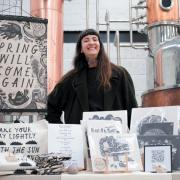It's exciting times for visitors and staff alike at
Fort Nelson as work has already begun on its redevelopment. Here, Veronica Cowan talks to those involved in the �3.5 million project
Bang on time at the end of 2009, the explosive launch of the Fort Nelson renovation began. In the firing line was a 1930s bungalow, blown up by a salvo from a cannon, so that work could commence on enhanced facilities at the museum. The Heritage Lottery Fund bit the bullet and is shelling out �2 million towards the �3.5 million renovation. Royal Armouries Museum director Peter Armstrong said: “It is exciting to see the project get off the ground after months of hard work, negotiations and planning. The grant secures the long-term future of the only national museum in the area and of the only Palmerston Fort regularly open to the general public. It is a very special place.”
"It's a tactile collection...we want to break down the barriers that exist at a lot of museums"
Facing the challengeIt certainly is, but this monument to the skills and ingenuity of Victorian engineering and architecture was designed to deter intruders, so making it a welcoming visitor attraction must be a challenge. Sean Mannie, head of Royal Armouries South who runs the Fort, explained that visitor numbers have doubled in the last five years, and “we couldn’t get more in.” In turning the Fort into a heritage attraction, “we had to rethink it, and turn it on its head with the visitor centre at the front on the roadside.” Demolition of the bungalow means visitors will be able to park on the right side of road, explains Malcolm McGregor, a director of Pringle Richard Sharratt, the architects of the project, who described some of the conservation hurdles that have to be surmounted with such projects: “For example, we had to get a bat licence because we, wrongly as it turned out, thought there were bats in the bungalow.” He explained that the next stage of the work would be a dig to record any archeological remains, “and we will have to deal with Swallow boxes and any habitat issues.”
Collectors piecesAs well as being a visitor attraction, Fort Nelson houses an important national collection. Winchester-based Professor Richard Holmes, military historian, BBC broadcaster and trustee of the Royal Armouries Board, said: “This will revolutionise public access, but as Fort Nelson is also the national centre of artillery, the development will make it possible to display important items like Saddam Hussein’s Supergun.” Sue Runyard, Committee Member for the Heritage Lottery Fund in the South East, didn’t think she would be interested in the Fort, “as I was not interested in artillery”, but found it “a very surprising place, and a real slice of history, but people whizz past it on the M27 and don’t know what it is.” They certainly will once the project is completed.
There will be a state-of-the-art education centre, including a ‘classroom of the future’
Breaking down barriersOne thing that struck me when I went there was the relaxed atmosphere and lack of ‘do not touch’ signs: “It is a tactile collection,” agrees Mr Mannie, while Professor Holmes remarks: “We want to break down the barriers that exist at a lot of museums.” It is also free to enter, which is very important for families, and will remain open throughout the building phase in 2010. Although it is a museum, the present military conflicts give it a topical resonance, notes Mr Mannie, who added: “These great weapons of war can be related to what is going on today, and although the ways of dealing with the on-going conflict have changed, the basic principles are the same.”Another group of enthusiasts with an interest in the project are the Palmerston Forts Society, an educational charity dedicated to the study and preservation of Victorian fortification and associated artillery. Geoff Hallett, its secretary, was upbeat: “We are as enthusiastic about the Lottery grant as the Royal Armouries, especially as it comes in the year of our 25th anniversary.” He recalls that the Fort was an overgrown burnt-out ruin, and enthusiasts, with the support of Hampshire County Council, wanted to conserve it, and started showing people around at weekends. The rest, as they say, is history.
ON THE FORUMSLet us know your feelings on the brand new Fort Nelson at hampshire.greatbritishlife.co.uk
Fort NelsonThe storyThis Victorian fortification is one of the Palmerston Forts, named after Lord Palmerston, the Prime Minister who developed them. As it was feared the French might attack over land, a line of forts were built along Portsdown Hill, to guard Portsmouth’s dockyard from being shelled from miles around, so the forts were designed so that all their main weapons face inland. In the event, the forts never were attacked, and once the French threat was neutralised, with the capture of Napoleon III during the Franco-Prussian war of 1870, the forts came to be dubbed ‘Palmerston’s Folly’, as they had been very costly to build. Fort Nelson was used in the First World War as a transit camp for troops embarking for Europe, and was also called to arms during the Second World War when, supplying ammunition to anti-aircraft batteries, it protected Portsmouth dockyard from German bombers. It served as a naval depot until the 1950s, and was later bought by Hampshire Country Council, which leased it to The Royal Armouries, Britain’s oldest museum.
What to expectThe entrance will be re-sited so visitors cross an original drawbridge, and a lift between both levels of the Fort will facilitate wider access. The new visitor centre, shop and caf� will be outside the walls of the Fort, so it can be used by passing traffic as well as visitors, and new parking facilities next to the site will give easy access to the famous Nelson Monument on Monument Lane, Portsdown. An entrance gallery – the Orienteur – will display dramatic and iconic cannon, and there will be a state-of-the-art education centre, including a ‘classroom of the future’.
5 things you didn’t know about Fort Nelson• It is one of five defensive forts on the summit of Portsdown Hill. • It is not named after Admiral Lord Nelson, but after his monument in Portsdown, built over 30 years before Nelson’s Column in Trafalgar Square. Not be confused with the former fur trade colony in Alaska, also called Fort Nelson.• The bricks used to build it – ‘Fareham Reds’ – are the same as those used to build the Albert Hall.• It houses over 350 cannon dating back over 600 years. • The collection originated from HM Tower of London and has been on display in Hampshire since 1995.


























